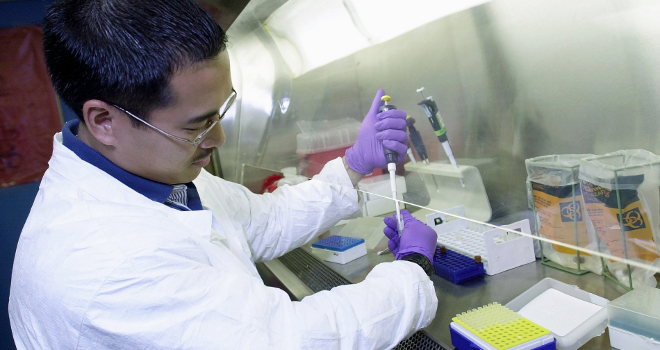A trio of government agencies are working to develop a project that sounds like something out of a science fiction novel: They’re working to create a tiny chip, made with bioengineered human tissue that researchers hope will allow them to model how drugs and vaccines could potentially affect the human body.
The new project is a joint effort between the Defense Advanced Research Projects Agency (DARPA,) the Food and Drug Administration (FDA) and the National Institutes of Health (NIH.)
The chip, which was created through DARPA’s Accelerated Manufacture of Pharmaceuticals Program, is intended to help the Defense Department quickly develop and distribute medical countermeasures against attacks against American troops. According to a recently released agency announcement, the completed chip will simulate the circulatory, endocrine, gastrointestinal, immune, musculoskeletal, nervous, reproductive, respiratory and urinary systems.
DARPA expects to have chips available and ready for research by 2016.
The tiny chips will contain integrated cells from a variety of organs including the liver, heart and muscles. DARPA and the FDA will both be investing more than $70 million each into the project.
FDA Commissioner Margaret Hamburg claims the chips will revolutionize drug research:
The FDA is excited about this program to develop novel new platforms that can be used to screen drugs for safety and efficacy, without the use of animals and in a manner that better predicts what happens in people […] this cheaper, faster and more predictive approach to drug screening could speed the development and improve the evaluation of innovative medicines, bringing needed products to patients safer and faster.
The small chips will be able to quickly simulate interactions between different candidate drugs and vaccines. According to a DARPA statement, a division of labor between the different agencies has already been worked out:
DARPA researchers will concentrate their efforts on engineering platforms and the biology required for scientific proof of concept. The NIH’s National Center for Advancing Translational Sciences will focus on developing complementary microphysiological systems to mimic human physiology and pathology by taking advantage of recent advances in the field. Both agencies will work closely with the U.S. Food and Drug Administration throughout the process. FDA will provide scientific input to help ensure that the regulatory challenges of reviewing drug safety and efficacy are considered before and during development.
In promotional materials related to the project, DARPA explicitly stated that the goal of the chip project is to emphasize aggressive research and to remove barriers to innovation for protecting troops from existing diseases, pandemics and bioterrorism. A related program, the Accelerated Manufacture of Pharmaceuticals program, is currently undertaking experiments that will rapidly reduce the timespan needed to create anti-biological warfare vaccines.
One of the biggest hopes for the project is that the chips will simulate the human physiological system much more effectively than animal testing. Testing of anti-pandemic and anti-biological warfare drugs on human subjects is restricted for ethical reasons; these types of drugs are currently routinely tested on animals.






